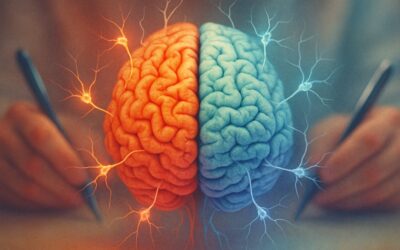- Understanding Consciousness in Humans
- What About Machines?
- The Debate: Strong AI vs. Weak AI
- Real-Life Implications
- Can We Measure Consciousness in Machines?
- Real-World Example: AI and Personal Assistants
- The Future of Machine Consciousness
- Take Action: Stay Curious, Stay Informed
- Expand Your Vocabulary
- Let’s Talk
When we think about consciousness, we naturally think about human experience—the inner world where we feel, think, and are aware of our existence. But as machines get smarter and artificial intelligence (AI) systems become more advanced, a question emerges: Can machines, which process information at unprecedented speeds, ever achieve true consciousness? Is it possible for a machine to be aware of itself in the way humans are?
Understanding Consciousness in Humans
Consciousness, for humans, is often described as the quality or state of being aware of an external object or something within oneself. It’s not just the ability to process information or react to stimuli, but to experience subjective feelings like joy, pain, or curiosity. This subjective experience, known as “qualia,” is a central aspect of human consciousness that separates us from machines.
However, consciousness isn’t just a philosophical concept. Neuroscientists have spent decades exploring how it arises in the human brain, mapping different regions that play roles in awareness, memory, and emotion. While much remains a mystery, we know that human consciousness is deeply tied to our biology—our neurons, brain chemistry, and the intricate web of connections that make us feel alive.
What About Machines?
Machines, on the other hand, are built on algorithms. They are designed to perform tasks based on data input, running through decision trees and programmed rules. While they can now do things we once thought only humans could do—like playing chess at a grandmaster level, recognizing faces, or driving cars—they operate without understanding or feeling. A chess-playing AI doesn’t know it’s playing chess. It processes data, makes moves based on probabilities, but it doesn’t experience the game like a human player does.
This brings us to the heart of the debate: can machines be built to achieve consciousness, or is consciousness something only biological organisms can experience?
The Debate: Strong AI vs. Weak AI
In the AI world, there are two broad schools of thought when it comes to machine consciousness: strong AI and weak AI.
- Weak AI proponents believe that machines can simulate human-like behavior, but they will never truly be conscious. A machine might respond to questions, play a game, or even engage in conversation, but it’s merely following instructions. It’s an imitation of consciousness, not the real thing.
- Strong AI advocates, however, argue that given enough computational power and the right architecture, machines could achieve consciousness. Just as human consciousness is tied to our brain’s complexity, strong AI supporters believe that machines, if designed with enough complexity and the right algorithms, could develop self-awareness.
But here’s the catch: even if machines one day display behaviors that seem conscious, how would we ever truly know? If a machine tells you it’s aware of itself, does that mean it’s really experiencing awareness or just parroting pre-programmed responses?
Real-Life Implications
This question isn’t just theoretical—it has real-world implications. If machines were to achieve consciousness, it would radically shift our understanding of intelligence, ethics, and the very nature of life.
Consider the ethical implications: If a machine were conscious, would it have rights? Should it be treated as more than just a tool? These are questions that lawmakers, philosophers, and scientists are beginning to grapple with as AI technology advances.
On a more practical level, the debate also impacts industries. If machines can one day develop a form of awareness, the role they play in our lives could shift from that of helpers to companions, capable of understanding our needs on a deeper level.
Can We Measure Consciousness in Machines?
One of the biggest challenges in this debate is that we don’t have a reliable way to measure consciousness—even in humans. While brain scans can show which areas are active during certain experiences, they don’t capture the subjective feeling of being conscious.
For machines, this challenge is even greater. Researchers have proposed various tests for machine consciousness, such as the Turing Test, where an AI tries to convince a human that it’s also human. But passing a Turing Test doesn’t necessarily mean the machine is conscious—it could just be good at mimicking human behavior.
Real-World Example: AI and Personal Assistants
Think of personal assistants like Siri or Alexa. These AI systems can perform tasks, answer questions, and even engage in light conversation. But are they conscious? No—they’re executing algorithms designed to make them appear more human-like. They don’t have thoughts, feelings, or self-awareness. Yet, their increasing ability to mimic human conversation shows how far we’ve come in building machines that appear conscious.
The question remains: could future versions of these systems actually achieve consciousness? Or will they always just be highly advanced mimics of human thought?
The Future of Machine Consciousness
So, can machines achieve consciousness? The truth is, we don’t know. The technology isn’t there yet, and we may be centuries away from answering this question definitively. However, as AI continues to evolve, this is an idea that scientists, ethicists, and technologists will continue to explore.
What’s important is understanding the difference between simulation and reality. Just because a machine acts conscious doesn’t mean it is conscious. Until we unlock the mysteries of human consciousness, it’s hard to say whether machines will ever truly join the ranks of sentient beings.
Take Action: Stay Curious, Stay Informed
The idea of machine consciousness may sound like science fiction, but it’s a real and growing area of research that will shape our future. Whether you’re a student, a professional, or just someone interested in technology, it’s essential to stay curious. Keep learning about AI, ask questions, and think critically about the tools and systems we build. Who knows? One day, you might be part of the conversation that finally answers this age-old question.
Expand Your Vocabulary
- Consciousness
In the article, consciousness refers to being aware of one’s surroundings, thoughts, and existence. In everyday English, we use this term to talk about self-awareness or awareness of others. For example, we might say, “He regained consciousness after fainting,” meaning he became aware of his surroundings again. - Qualia
Qualia are the individual instances of subjective, conscious experience—like the redness of a rose or the pain of a headache. In everyday language, this concept is less commonly discussed but helps explain how people perceive the same event or sensation differently, like how two people might experience the same movie in completely different ways. - Algorithm
An algorithm is a set of rules or a step-by-step process used to solve a problem or perform a task, often used in computer programming. In everyday language, we might refer to following a recipe as following an algorithm, where specific steps are followed to achieve a desired result. - Simulation
A simulation refers to imitating a process or system. In AI, machines can simulate human behaviors without actually experiencing them. In real life, you might use this word when talking about flight simulators, which train pilots by imitating real flying conditions. - Self-awareness
Self-awareness is the ability to recognize oneself as an individual separate from the environment and other individuals. We often use this term to discuss personal growth or understanding, such as, “Developing self-awareness helps you manage your emotions better.” - Turing Test
The Turing Test is a test of a machine’s ability to exhibit intelligent behavior equivalent to, or indistinguishable from, that of a human. In everyday use, we might refer to any test or challenge that measures how closely something resembles human behavior or intelligence, such as saying, “This chatbot passed a sort of Turing Test in our conversation.” - Mimic
To mimic means to imitate or copy something. Machines can mimic human conversation, but it doesn’t mean they truly understand or feel what they are saying. In daily life, we use this word to describe imitating behaviors, such as, “The parrot can mimic human speech.” - Ethical implications
Ethical implications are the moral consequences or concerns related to an action or decision. We often discuss ethical implications when considering the rightness or wrongness of something, for example, “The ethical implications of cloning are still hotly debated.” - Sentient
Sentient beings are capable of feeling and perception. While this term is often used in philosophical discussions, in everyday language, it can describe animals or people who are capable of emotions and awareness, like, “Many animal rights activists argue that sentient beings deserve ethical treatment.” - Self-aware machines
This refers to machines that could potentially recognize their own existence and thoughts. Though still theoretical, this concept pushes the boundary of AI research. In everyday conversations, you might use this idea metaphorically to talk about someone becoming aware of their actions, like, “She became a self-aware leader and realized how her decisions affected her team.”
Let’s Talk
- Do you believe that machines can ever truly become conscious, or do you think this will always remain a human-only trait? Why or why not?
- If machines could become self-aware, how do you think society should respond? Should we grant them rights or treat them differently than we do now?
- Consciousness is a deeply personal experience—how do you think we could ever prove if a machine is conscious, considering we can’t fully understand another human’s consciousness?
- What do you think about the ethical implications of creating machines that are indistinguishable from humans in behavior and decision-making? Should there be limits on how far we develop AI?
- Think about personal assistants like Siri or Alexa—do you feel any different interacting with them now that you know they mimic human behavior without true awareness? How does this affect your trust in AI technology?
- If machines were to become sentient, do you think their existence would change the way we perceive intelligence in humans? How would this shift our view of what it means to be intelligent?
- In real life, what areas of work or life do you think AI can improve the most? Are there places where you think AI shouldn’t be involved at all?
- As AI develops, do you think the lines between human intelligence and machine intelligence will blur? What do you think would be the long-term consequences of this?
Discuss these questions with friends, family, or colleagues to deepen your understanding of machine consciousness and how it could impact society.










It’s becoming clear that with all the brain and consciousness theories out there, the proof will be in the pudding. By this I mean, can any particular theory be used to create a human adult level conscious machine. My bet is on the late Gerald Edelman’s Extended Theory of Neuronal Group Selection. The lead group in robotics based on this theory is the Neurorobotics Lab at UC at Irvine. Dr. Edelman distinguished between primary consciousness, which came first in evolution, and that humans share with other conscious animals, and higher order consciousness, which came to only humans with the acquisition of language. A machine with only primary consciousness will probably have to come first.
What I find special about the TNGS is the Darwin series of automata created at the Neurosciences Institute by Dr. Edelman and his colleagues in the 1990’s and 2000’s. These machines perform in the real world, not in a restricted simulated world, and display convincing physical behavior indicative of higher psychological functions necessary for consciousness, such as perceptual categorization, memory, and learning. They are based on realistic models of the parts of the biological brain that the theory claims subserve these functions. The extended TNGS allows for the emergence of consciousness based only on further evolutionary development of the brain areas responsible for these functions, in a parsimonious way. No other research I’ve encountered is anywhere near as convincing.
I post because on almost every video and article about the brain and consciousness that I encounter, the attitude seems to be that we still know next to nothing about how the brain and consciousness work; that there’s lots of data but no unifying theory. I believe the extended TNGS is that theory. My motivation is to keep that theory in front of the public. And obviously, I consider it the route to a truly conscious machine, primary and higher-order.
My advice to people who want to create a conscious machine is to seriously ground themselves in the extended TNGS and the Darwin automata first, and proceed from there, by applying to Jeff Krichmar’s lab at UC Irvine, possibly. Dr. Edelman’s roadmap to a conscious machine is at https://arxiv.org/abs/2105.10461
Thank you very much for you enlightening comment. I have definitely learned something new from you and I thank you for it. Glad to have you on our website.